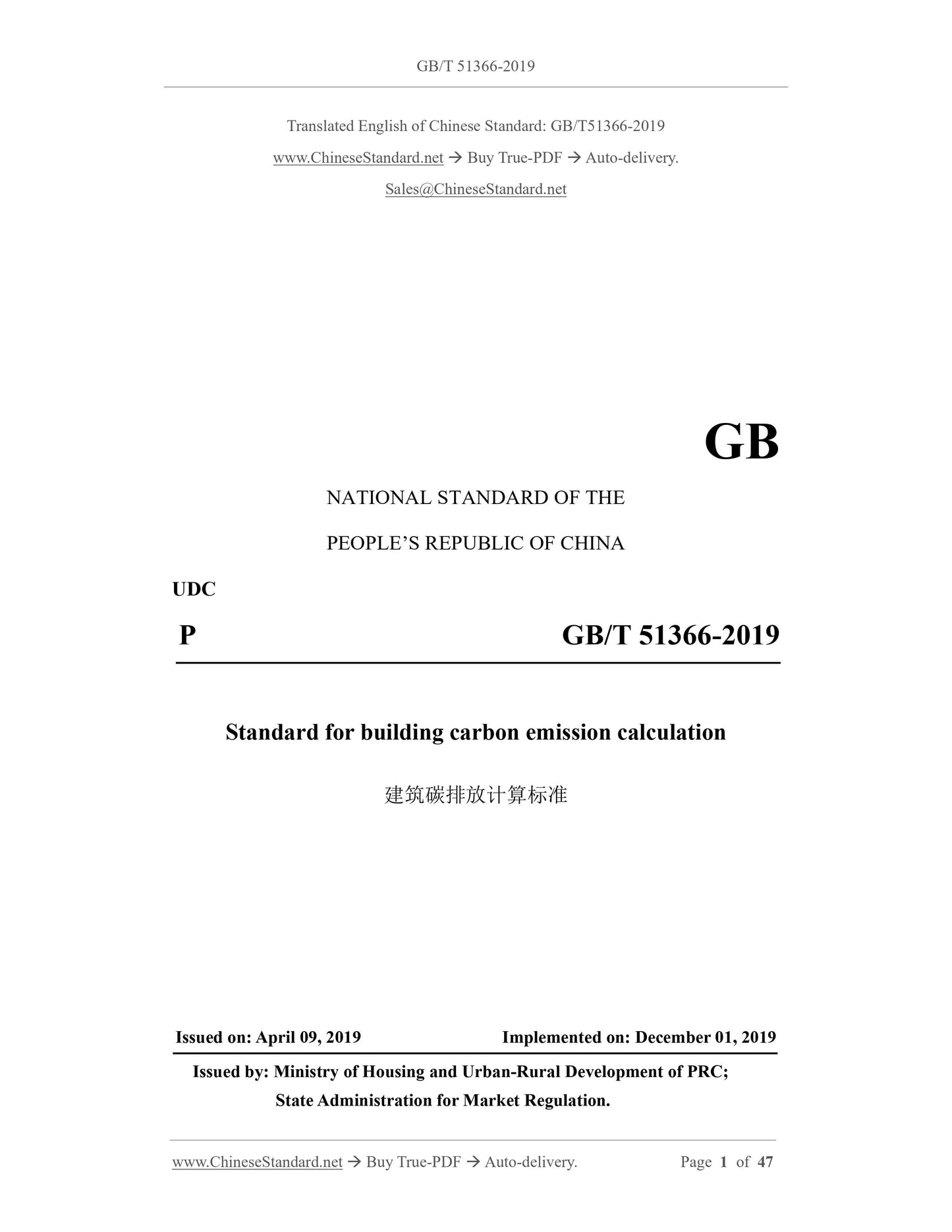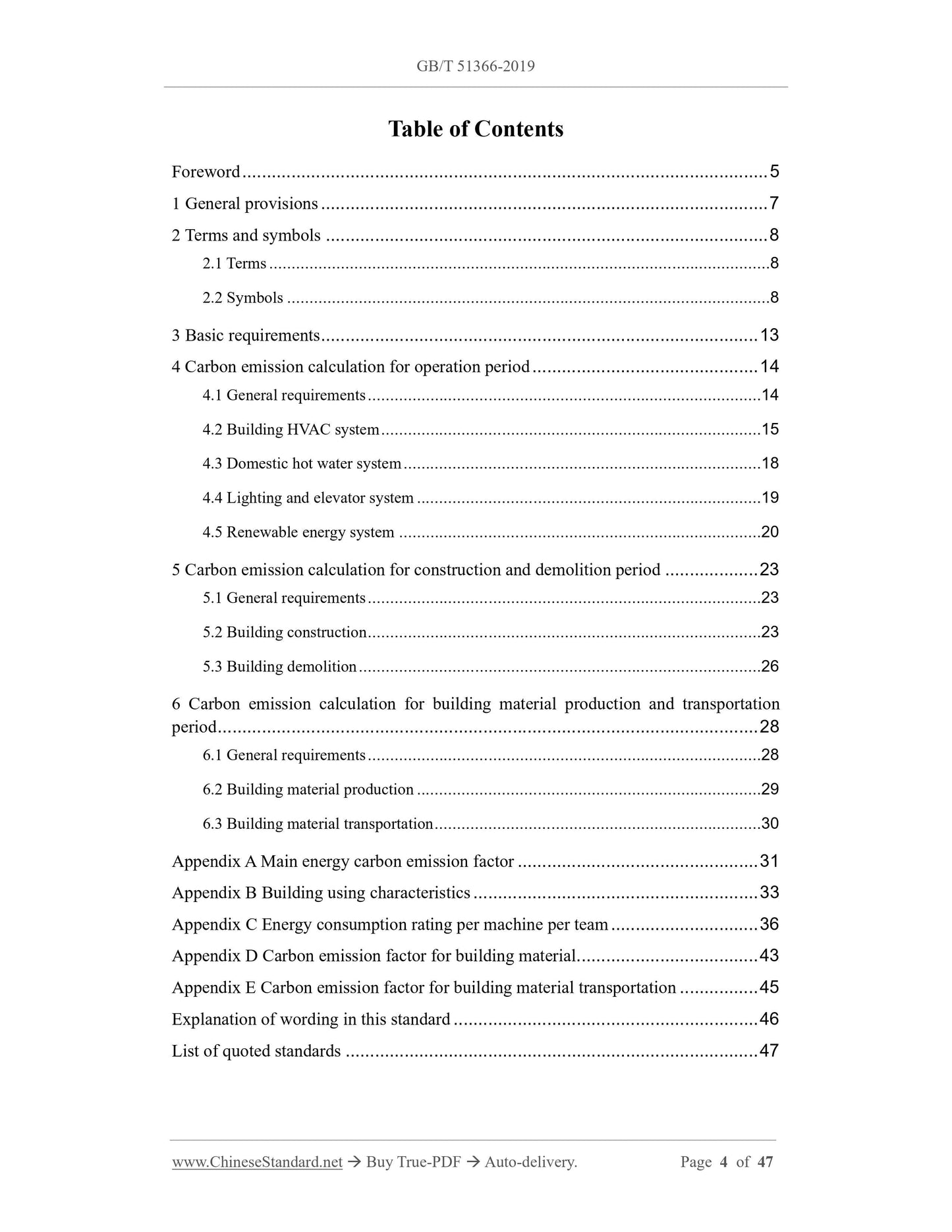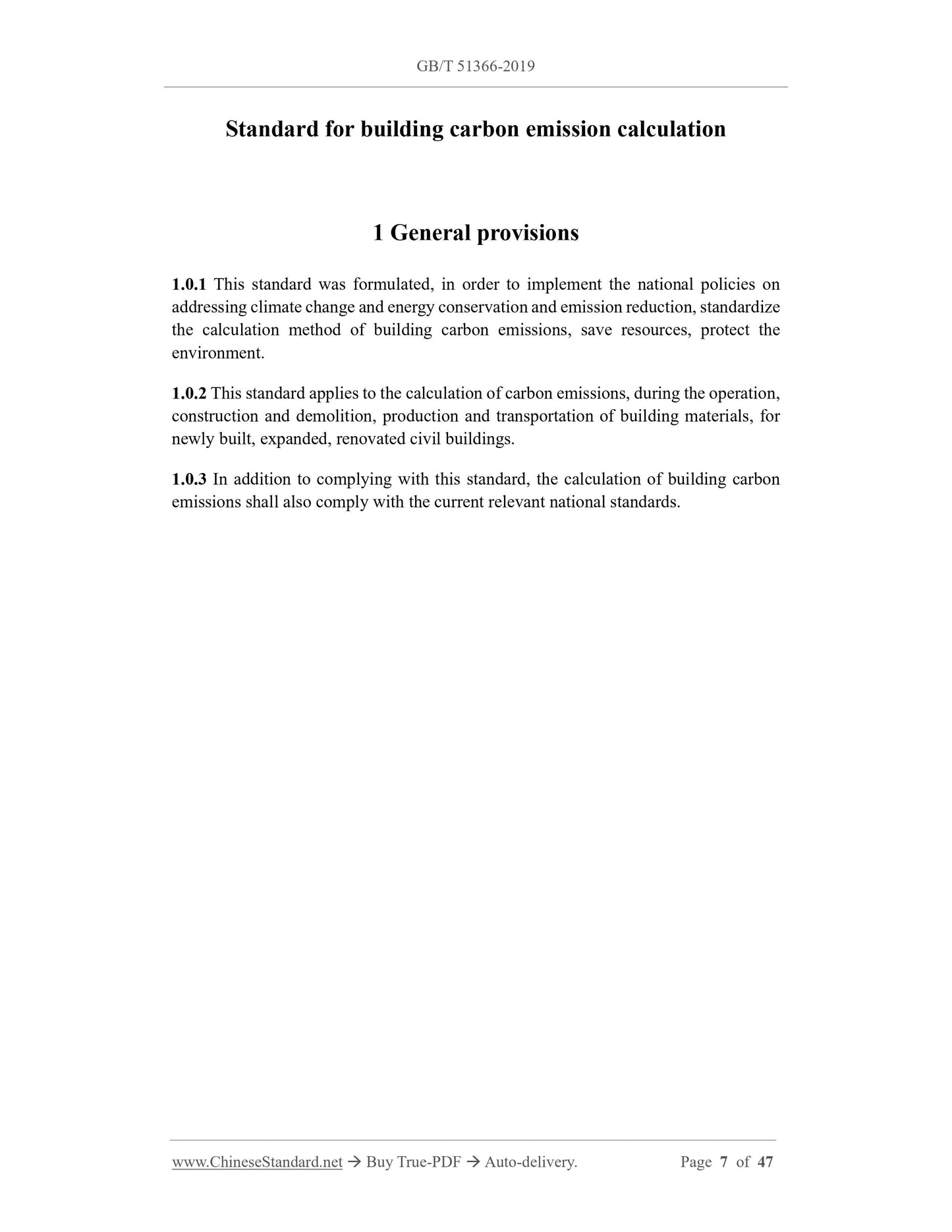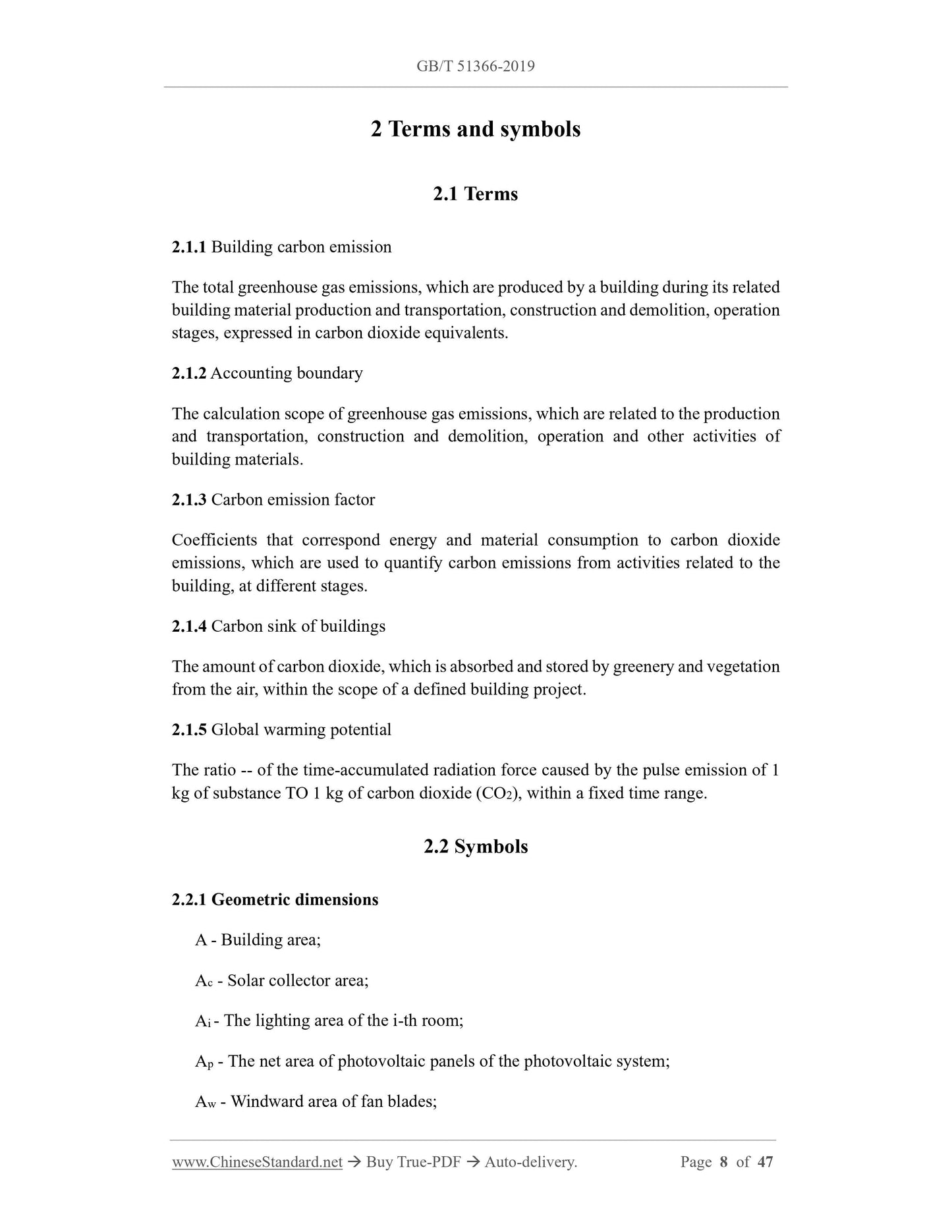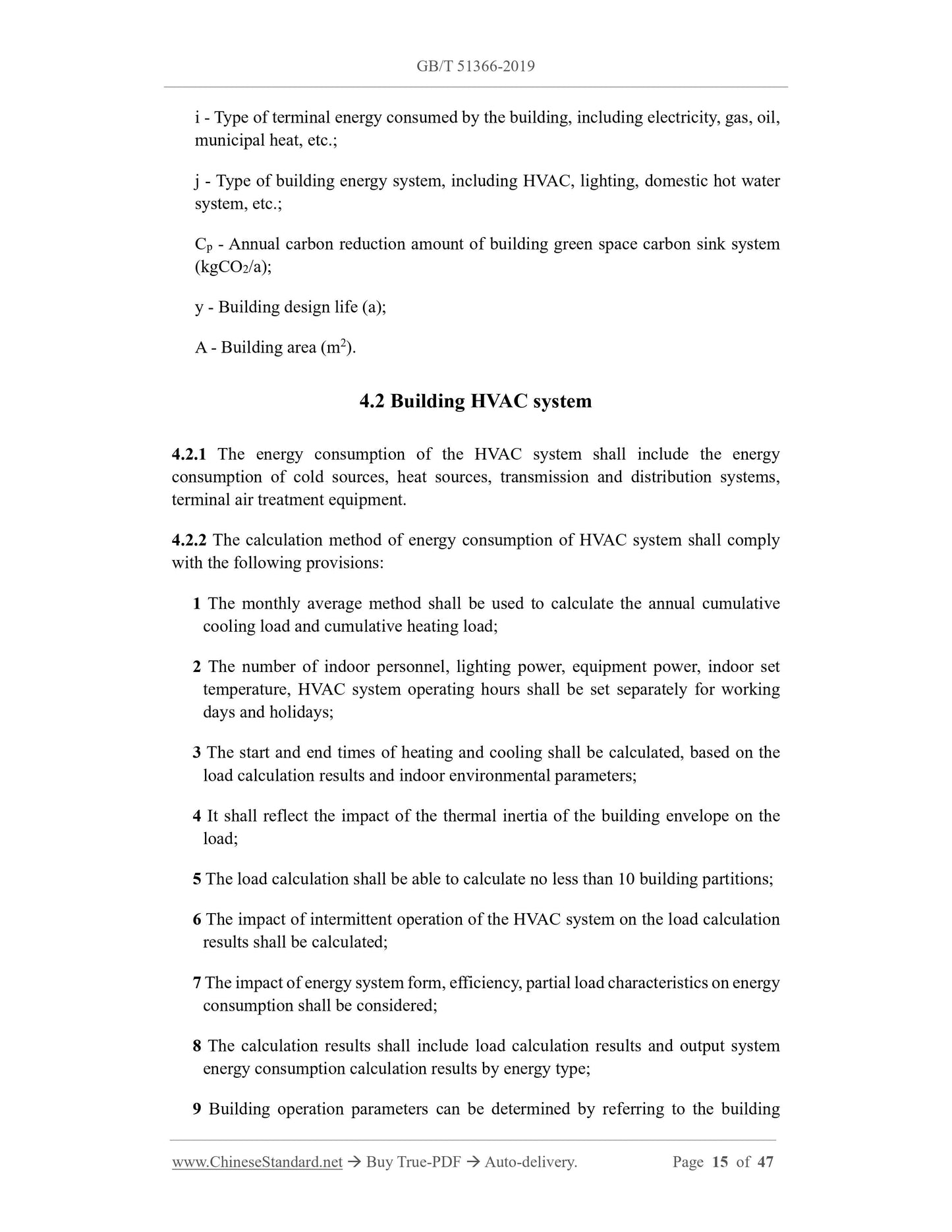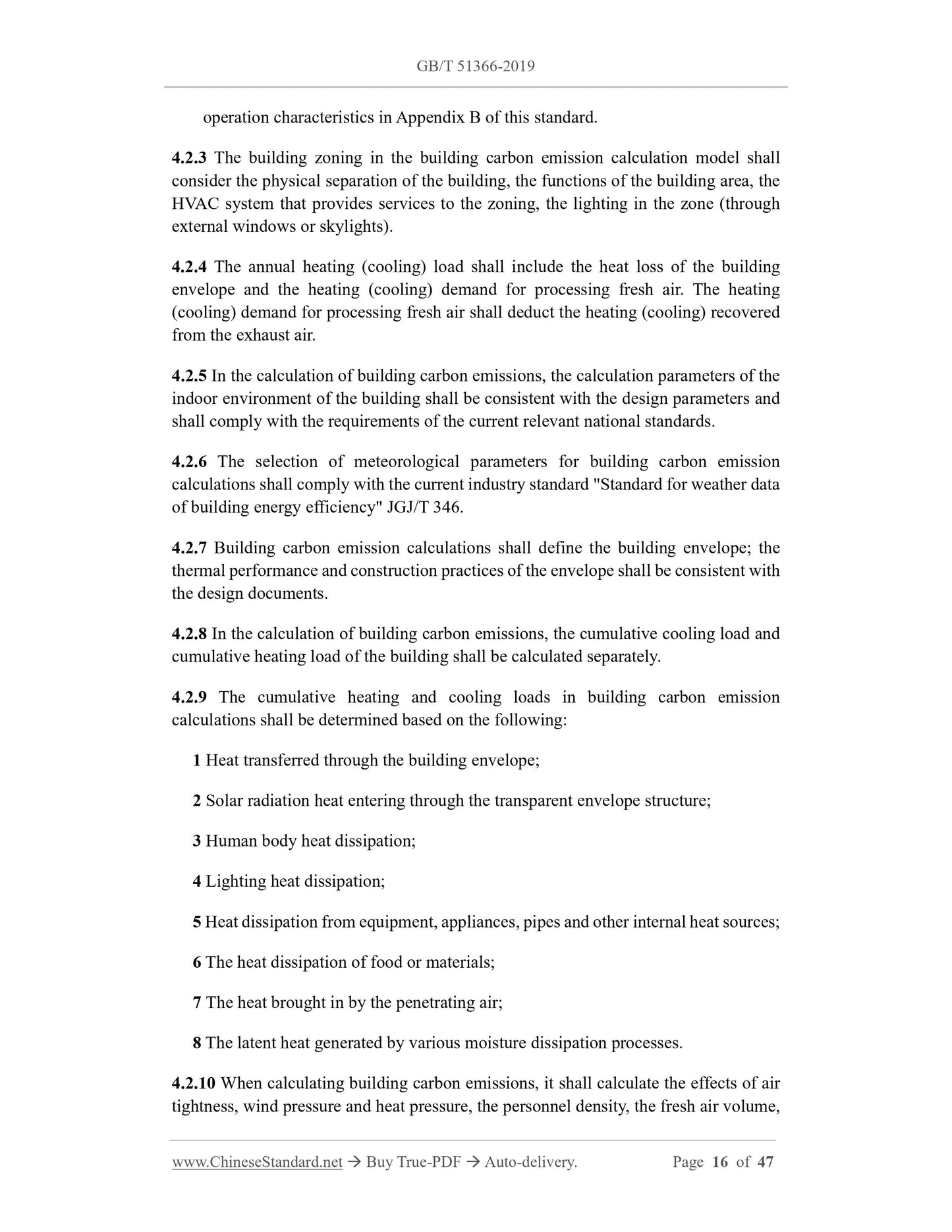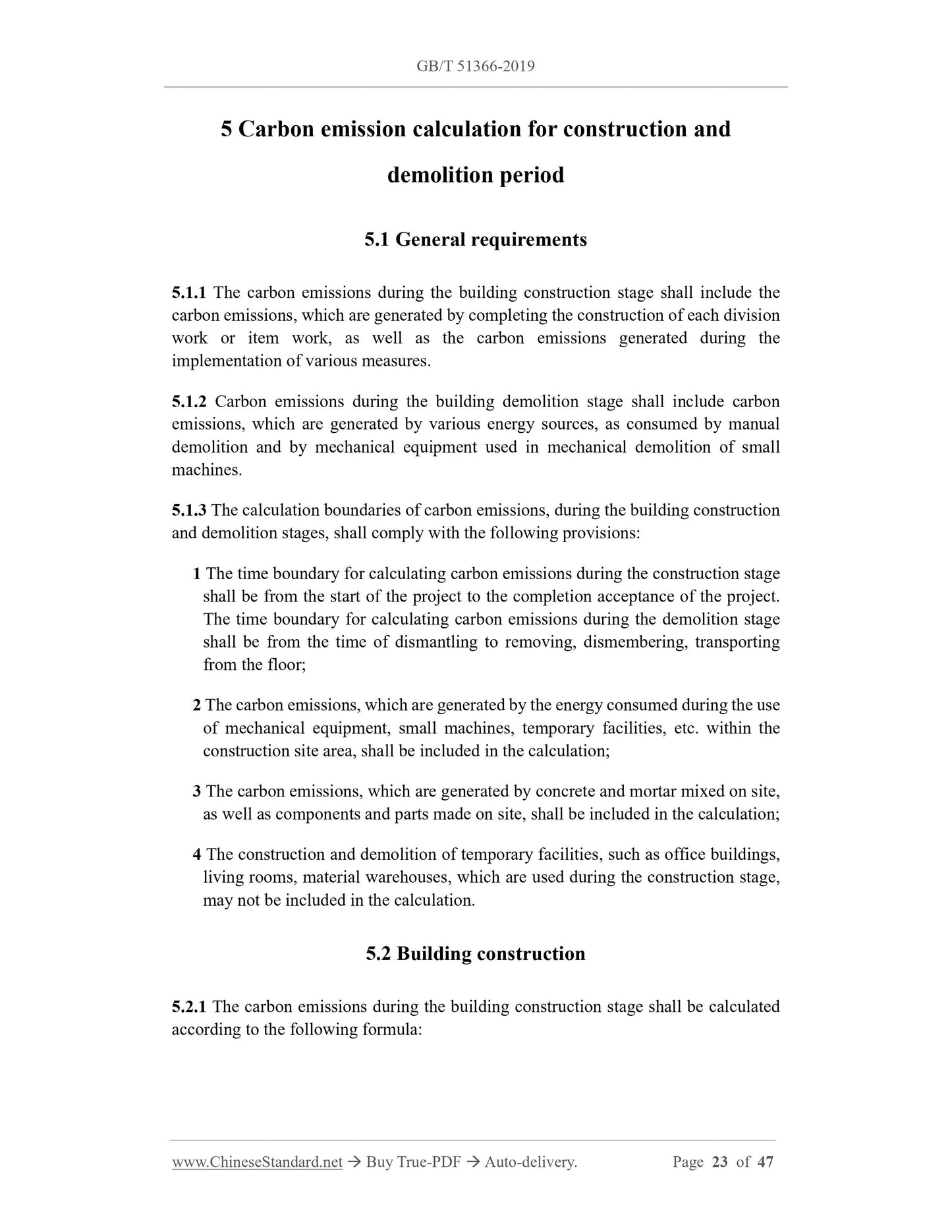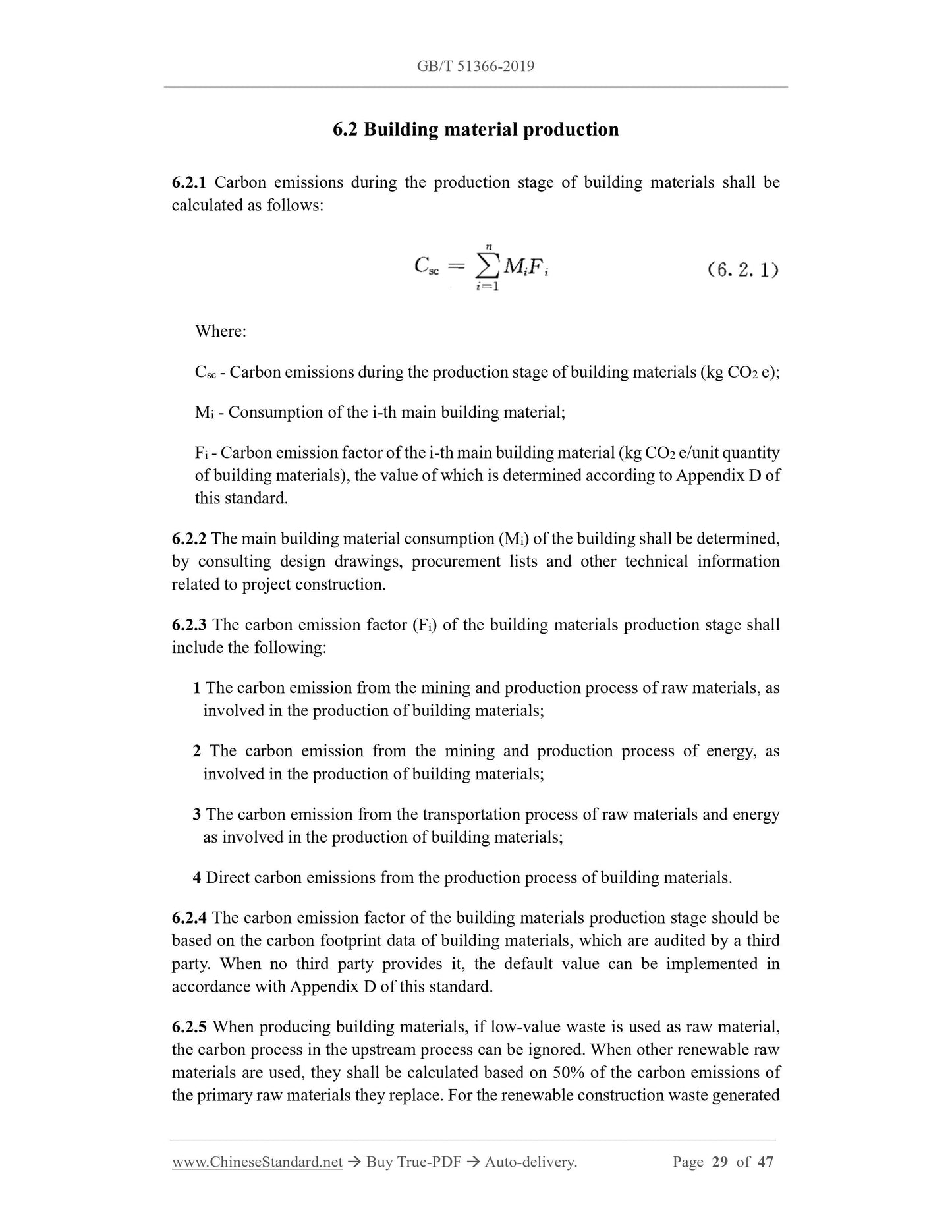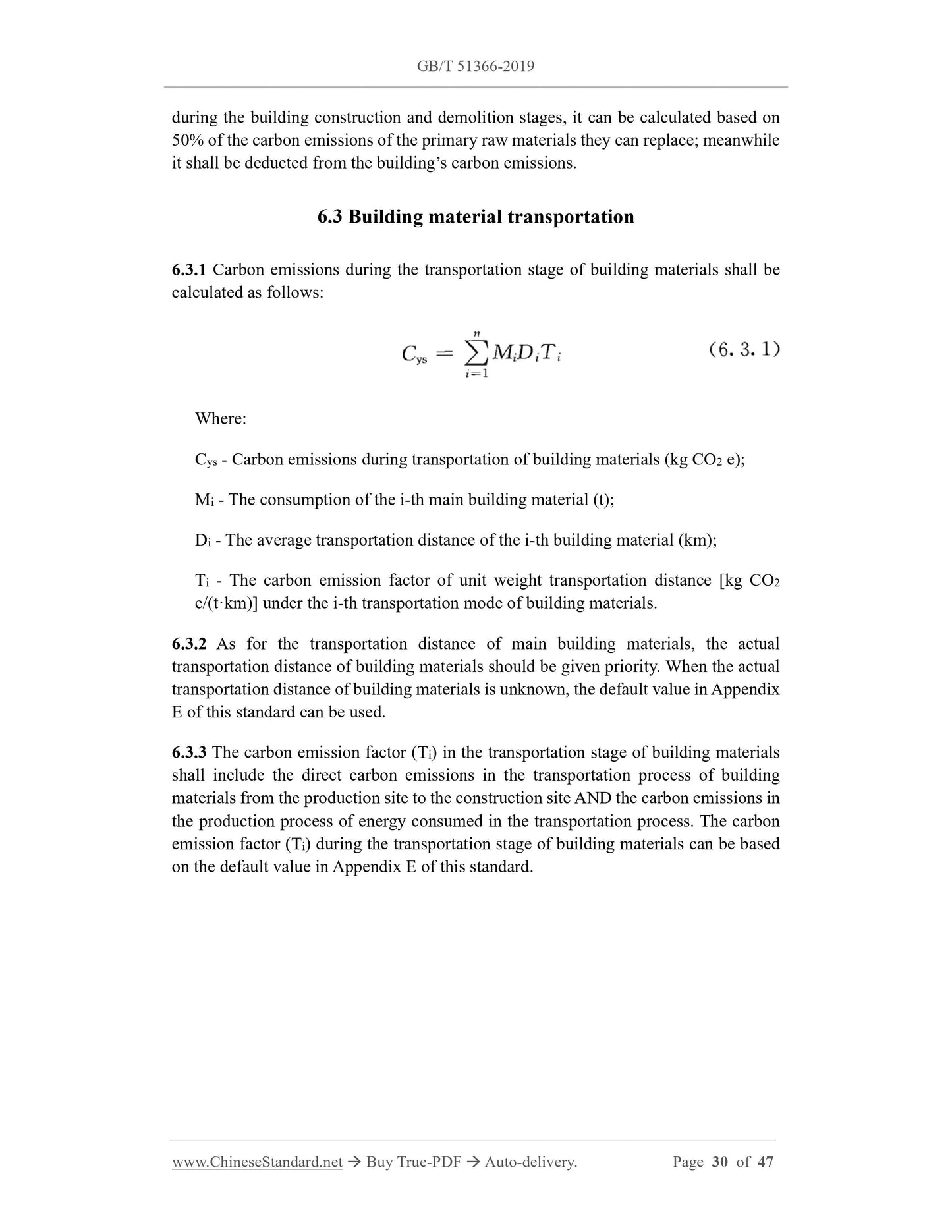1
/
of
9
www.ChineseStandard.us -- Field Test Asia Pte. Ltd.
GB/T 51366-2019 English PDF (GB/T51366-2019)
GB/T 51366-2019 English PDF (GB/T51366-2019)
Regular price
$610.00
Regular price
Sale price
$610.00
Unit price
/
per
Shipping calculated at checkout.
Couldn't load pickup availability
GB/T 51366-2019: Standard for building carbon emission calculation
Delivery: 9 seconds. Download (& Email) true-PDF + Invoice.
Get Quotation: Click GB/T 51366-2019 (Self-service in 1-minute)
Historical versions (Master-website): GB/T 51366-2019
Preview True-PDF (Reload/Scroll-down if blank)
GB/T 51366-2019
GB
NATIONAL STANDARD OF THE
PEOPLE’S REPUBLIC OF CHINA
UDC
P GB/T 51366-2019
Standard for building carbon emission calculation
ISSUED ON: APRIL 09, 2019
IMPLEMENTED ON: DECEMBER 01, 2019
Issued by: Ministry of Housing and Urban-Rural Development of PRC;
State Administration for Market Regulation.
Table of Contents
Foreword ... 5
1 General provisions ... 7
2 Terms and symbols ... 8
2.1 Terms ... 8
2.2 Symbols ... 8
3 Basic requirements ... 13
4 Carbon emission calculation for operation period ... 14
4.1 General requirements ... 14
4.2 Building HVAC system ... 15
4.3 Domestic hot water system ... 18
4.4 Lighting and elevator system ... 19
4.5 Renewable energy system ... 20
5 Carbon emission calculation for construction and demolition period ... 23
5.1 General requirements ... 23
5.2 Building construction ... 23
5.3 Building demolition ... 26
6 Carbon emission calculation for building material production and transportation
period ... 28
6.1 General requirements ... 28
6.2 Building material production ... 29
6.3 Building material transportation ... 30
Appendix A Main energy carbon emission factor ... 31
Appendix B Building using characteristics ... 33
Appendix C Energy consumption rating per machine per team ... 36
Appendix D Carbon emission factor for building material ... 43
Appendix E Carbon emission factor for building material transportation ... 45
Explanation of wording in this standard ... 46
List of quoted standards ... 47
Standard for building carbon emission calculation
1 General provisions
1.0.1 This standard was formulated, in order to implement the national policies on
addressing climate change and energy conservation and emission reduction, standardize
the calculation method of building carbon emissions, save resources, protect the
environment.
1.0.2 This standard applies to the calculation of carbon emissions, during the operation,
construction and demolition, production and transportation of building materials, for
newly built, expanded, renovated civil buildings.
1.0.3 In addition to complying with this standard, the calculation of building carbon
emissions shall also comply with the current relevant national standards.
2 Terms and symbols
2.1 Terms
2.1.1 Building carbon emission
The total greenhouse gas emissions, which are produced by a building during its related
building material production and transportation, construction and demolition, operation
stages, expressed in carbon dioxide equivalents.
2.1.2 Accounting boundary
The calculation scope of greenhouse gas emissions, which are related to the production
and transportation, construction and demolition, operation and other activities of
building materials.
2.1.3 Carbon emission factor
Coefficients that correspond energy and material consumption to carbon dioxide
emissions, which are used to quantify carbon emissions from activities related to the
building, at different stages.
2.1.4 Carbon sink of buildings
The amount of carbon dioxide, which is absorbed and stored by greenery and vegetation
from the air, within the scope of a defined building project.
2.1.5 Global warming potential
The ratio -- of the time-accumulated radiation force caused by the pulse emission of 1
kg of substance TO 1 kg of carbon dioxide (CO2), within a fixed time range.
2.2 Symbols
2.2.1 Geometric dimensions
A - Building area;
Ac - Solar collector area;
Ai - The lighting area of the i-th room;
Ap - The net area of photovoltaic panels of the photovoltaic system;
Aw - Windward area of fan blades;
i - Type of terminal energy consumed by the building, including electricity, gas, oil,
municipal heat, etc.;
j - Type of building energy system, including HVAC, lighting, domestic hot water
system, etc.;
Cp - Annual carbon reduction amount of building green space carbon sink system
(kgCO2/a);
y - Building design life (a);
A - Building area (m2).
4.2 Building HVAC system
4.2.1 The energy consumption of the HVAC system shall include the energy
consumption of cold sources, heat sources, transmission and distribution systems,
terminal air treatment equipment.
4.2.2 The calculation method of energy consumption of HVAC system shall comply
with the following provisions:
1 The monthly average method shall be used to calculate the annual cumulative
cooling load and cumulative heating load;
2 The number of indoor personnel, lighting power, equipment power, indoor set
temperature, HVAC system operating hours shall be set separately for working
days and holidays;
3 The start and end times of heating and cooling shall be calculated, based on the
load calculation results and indoor environmental parameters;
4 It shall reflect the impact of the thermal inertia of the building envelope on the
load;
5 The load calculation shall be able to calculate no less than 10 building partitions;
6 The impact of intermittent operation of the HVAC system on the load calculation
results shall be calculated;
7 The impact of energy system form, efficiency, partial load characteristics on energy
consumption shall be considered;
8 The calculation results shall include load calculation results and output system
energy consumption calculation results by energy type;
9 Building operation parameters can be determined by referring to the building
operation characteristics in Appendix B of this standard.
4.2.3 The building zoning in the building carbon emission calculation model shall
consider the physical separation of the building, the functions of the building area, the
HVAC system that provides services to the zoning, the lighting in the zone (through
external windows or skylights).
4.2.4 The annual heating (cooling) load shall include the heat loss of the building
envelope and the heating (cooling) demand for processing fresh air. The heating
(cooling) demand for processing fresh air shall deduct the heating (cooling) recovered
from the exhaust air.
4.2.5 In the calculation of building carbon emissions, the calculation parameters of the
indoor environment of the building shall be consistent with the design parameters and
shall comply with the requirements of the current relevant national standards.
4.2.6 The selection of meteorological parameters for building carbon emission
calculations shall comply with the current industry standard "Standard for weather data
of building energy efficiency" JGJ/T 346.
4.2.7 Building carbon emission calculations shall define the building envelope; the
thermal performance and construction practices of the envelope shall be consistent with
the design documents.
4.2.8 In the calculation of building carbon emissions, the cumulative cooling load and
cumulative heating load of the building shall be calculated separately.
4.2.9 The cumulative heating and cooling loads in building carbon emission
calculations shall be determined based on the following:
1 Heat transferred through the building envelope;
2 Solar radiation heat entering through the transparent envelope structure;
3 Human body heat dissipation;
4 Lighting heat dissipation;
5 Heat dissipation from equipment, appliances, pipes and other internal heat sources;
6 The heat dissipation of food or materials;
7 The heat brought in by the penetrating air;
8 The latent heat generated by various moisture dissipation processes.
4.2.10 When calculating building carbon emissions, it shall calculate the effects of air
tightness, wind pressure and heat pressure, the personnel density, the fresh air volume,
5 Carbon emission calculation for construction and
demolition period
5.1 General requirements
5.1.1 The carbon emissions during the building construction stage shall include the
carbon emissions, which are generated by completing the construction of each division
work or item work, as well as the carbon emissions generated during the
implementation of various measures.
5.1.2 Carbon emissions during the building demolition stage shall include carbon
emissions, which are generated by various energy sources, as consumed by manual
demolition and by mechanical equipment used in mechanical demolition of small
machines.
5.1.3 The calculation boundaries of carbon emissions, during the building construction
and demolition stages, shall comply with the following provisions:
1 The time boundary for calculating carbon emissions during the construction stage
shall be from the start of the project to the completion acceptance of the project.
The time boundary for calculating carbon emissions during the demolition stage
shall be from the time of dismantling to removing, dismembering, transporting
from the floor;
2 The carbon emissions, which are generated by the energy consumed during the use
of mechanical equipment, small machines, temporary facilities, etc. within the
construction site area, shall be included in the calculation;
3 The carbon emissions, which are generated by concrete and mortar mixed on site,
as well as components and parts made on site, shall be included in the calculation;
4 The construction and demolition of temporary facilities, such as office buildings,
living rooms, material warehouses, which are used during the construction stage,
may not be included in the calculation.
5.2 Building construction
5.2.1 The carbon emissions during the building construction stage shall be calculated
according to the following formula:
6.2 Building material production
6.2.1 Carbon emissions during the production stage of building materials shall be
calculated as follows:
Where:
Csc - Carbon emissions during the production stage of building materials (kg CO2 e);
Mi - Consumption of the i-th main building material;
Fi - Carbon emission factor of the i-th main building material (kg CO2 e/unit quantity
of building materials), the value of which is determined according to Appendix D of
this standard.
6.2.2 The main building material consumption (Mi) of the building shall be determined,
by consulting design drawings, procurement lists and other technical information
related to project construction.
6.2.3 The carbon emission factor (Fi) of the building materials production stage shall
include the following:
1 The carbon emission from the mining and production process of raw materials, as
involved in the production of building materials;
2 The carbon emission from the mining and production process of energy, as
involved in the production of building materials;
3 The carbon emission from the transportation process of raw materials and energy
as involved in the production of building materials;
4 Direct carbon emissions from the production process of building materials.
6.2.4 The carbon emission factor of the building materials production stage should be
based on the carbon footprint data of building materials, which are audited by a third
party. When no third party provides it, the default value can be implemented in
accordance with Appendix D of this standard.
6.2.5 When producing building materials, if low-value waste is used as raw material,
the carbon process in the upstream process can be ignored. When other renewable raw
materials are used, they shall be calculated based on 50% of the carbon emissions of
the primary raw materials they replace. For the renewable construction waste generated
during the building construction and demolition stages, it can be calculated based on
50% of the carbon emissions of the primary raw materials they can replace; meanwhile
it shall be deducted from the building’s carbon emissions.
6.3 Building material transportation
6.3.1 Carbon emissions during the transportation stage of building materials shall be
calculated as follows:
Where:
Cys - Carbon emissions during transportation of building materials (kg CO2 e);
Mi - The consumption of the i-th main building material (t);
Di - The average transportation distance of the i-th building material (km);
Ti - The carbon emission factor of unit weight transportation distance [kg CO2
e/(t·km)] under the i-th transportation mode of building materials.
6.3.2 As for the transportation distance of main building materials, the actual
transportation distance of building materials should be given priority. When the actual
transportation distance of building materials is unknown, the default value in Appendix
E of this standard can be used.
6.3.3 The carbon emission factor (Ti) in the transportation stage of building materials
shall include the direct carbon emissions in the transportation process of building
materials from the production site to the construction site AND the carbon emissions in
the production process of energy consumed in the transportation process. The carbon
emission factor (Ti) during the transportation stage of building materials can be based
on the default value in Appendix E of this standard.
GB/T 51366-2019
GB
NATIONAL STANDARD OF THE
PEOPLE’S REPUBLIC OF CHINA
UDC
P GB/T 51366-2019
Standard for building carbon emission calculation
ISSUED ON: APRIL 09, 2019
IMPLEMENTED ON: DECEMBER 01, 2019
Issued by: Ministry of Housing and Urban-Rural Development of PRC;
State Administration for Market Regulation.
Table of Contents
Foreword ... 5
1 General provisions ... 7
2 Terms and symbols ... 8
2.1 Terms ... 8
2.2 Symbols ... 8
3 Basic requirements ... 13
4 Carbon emission calculation for operation period ... 14
4.1 General requirements ... 14
4.2 Building HVAC system ... 15
4.3 Domestic hot water system ... 18
4.4 Lighting and elevator system ... 19
4.5 Renewable energy system ... 20
5 Carbon emission calculation for construction and demolition period ... 23
5.1 General requirements ... 23
5.2 Building construction ... 23
5.3 Building demolition ... 26
6 Carbon emission calculation for building material production and transportation
period ... 28
6.1 General requirements ... 28
6.2 Building material production ... 29
6....
Delivery: 9 seconds. Download (& Email) true-PDF + Invoice.
Get Quotation: Click GB/T 51366-2019 (Self-service in 1-minute)
Historical versions (Master-website): GB/T 51366-2019
Preview True-PDF (Reload/Scroll-down if blank)
GB/T 51366-2019
GB
NATIONAL STANDARD OF THE
PEOPLE’S REPUBLIC OF CHINA
UDC
P GB/T 51366-2019
Standard for building carbon emission calculation
ISSUED ON: APRIL 09, 2019
IMPLEMENTED ON: DECEMBER 01, 2019
Issued by: Ministry of Housing and Urban-Rural Development of PRC;
State Administration for Market Regulation.
Table of Contents
Foreword ... 5
1 General provisions ... 7
2 Terms and symbols ... 8
2.1 Terms ... 8
2.2 Symbols ... 8
3 Basic requirements ... 13
4 Carbon emission calculation for operation period ... 14
4.1 General requirements ... 14
4.2 Building HVAC system ... 15
4.3 Domestic hot water system ... 18
4.4 Lighting and elevator system ... 19
4.5 Renewable energy system ... 20
5 Carbon emission calculation for construction and demolition period ... 23
5.1 General requirements ... 23
5.2 Building construction ... 23
5.3 Building demolition ... 26
6 Carbon emission calculation for building material production and transportation
period ... 28
6.1 General requirements ... 28
6.2 Building material production ... 29
6.3 Building material transportation ... 30
Appendix A Main energy carbon emission factor ... 31
Appendix B Building using characteristics ... 33
Appendix C Energy consumption rating per machine per team ... 36
Appendix D Carbon emission factor for building material ... 43
Appendix E Carbon emission factor for building material transportation ... 45
Explanation of wording in this standard ... 46
List of quoted standards ... 47
Standard for building carbon emission calculation
1 General provisions
1.0.1 This standard was formulated, in order to implement the national policies on
addressing climate change and energy conservation and emission reduction, standardize
the calculation method of building carbon emissions, save resources, protect the
environment.
1.0.2 This standard applies to the calculation of carbon emissions, during the operation,
construction and demolition, production and transportation of building materials, for
newly built, expanded, renovated civil buildings.
1.0.3 In addition to complying with this standard, the calculation of building carbon
emissions shall also comply with the current relevant national standards.
2 Terms and symbols
2.1 Terms
2.1.1 Building carbon emission
The total greenhouse gas emissions, which are produced by a building during its related
building material production and transportation, construction and demolition, operation
stages, expressed in carbon dioxide equivalents.
2.1.2 Accounting boundary
The calculation scope of greenhouse gas emissions, which are related to the production
and transportation, construction and demolition, operation and other activities of
building materials.
2.1.3 Carbon emission factor
Coefficients that correspond energy and material consumption to carbon dioxide
emissions, which are used to quantify carbon emissions from activities related to the
building, at different stages.
2.1.4 Carbon sink of buildings
The amount of carbon dioxide, which is absorbed and stored by greenery and vegetation
from the air, within the scope of a defined building project.
2.1.5 Global warming potential
The ratio -- of the time-accumulated radiation force caused by the pulse emission of 1
kg of substance TO 1 kg of carbon dioxide (CO2), within a fixed time range.
2.2 Symbols
2.2.1 Geometric dimensions
A - Building area;
Ac - Solar collector area;
Ai - The lighting area of the i-th room;
Ap - The net area of photovoltaic panels of the photovoltaic system;
Aw - Windward area of fan blades;
i - Type of terminal energy consumed by the building, including electricity, gas, oil,
municipal heat, etc.;
j - Type of building energy system, including HVAC, lighting, domestic hot water
system, etc.;
Cp - Annual carbon reduction amount of building green space carbon sink system
(kgCO2/a);
y - Building design life (a);
A - Building area (m2).
4.2 Building HVAC system
4.2.1 The energy consumption of the HVAC system shall include the energy
consumption of cold sources, heat sources, transmission and distribution systems,
terminal air treatment equipment.
4.2.2 The calculation method of energy consumption of HVAC system shall comply
with the following provisions:
1 The monthly average method shall be used to calculate the annual cumulative
cooling load and cumulative heating load;
2 The number of indoor personnel, lighting power, equipment power, indoor set
temperature, HVAC system operating hours shall be set separately for working
days and holidays;
3 The start and end times of heating and cooling shall be calculated, based on the
load calculation results and indoor environmental parameters;
4 It shall reflect the impact of the thermal inertia of the building envelope on the
load;
5 The load calculation shall be able to calculate no less than 10 building partitions;
6 The impact of intermittent operation of the HVAC system on the load calculation
results shall be calculated;
7 The impact of energy system form, efficiency, partial load characteristics on energy
consumption shall be considered;
8 The calculation results shall include load calculation results and output system
energy consumption calculation results by energy type;
9 Building operation parameters can be determined by referring to the building
operation characteristics in Appendix B of this standard.
4.2.3 The building zoning in the building carbon emission calculation model shall
consider the physical separation of the building, the functions of the building area, the
HVAC system that provides services to the zoning, the lighting in the zone (through
external windows or skylights).
4.2.4 The annual heating (cooling) load shall include the heat loss of the building
envelope and the heating (cooling) demand for processing fresh air. The heating
(cooling) demand for processing fresh air shall deduct the heating (cooling) recovered
from the exhaust air.
4.2.5 In the calculation of building carbon emissions, the calculation parameters of the
indoor environment of the building shall be consistent with the design parameters and
shall comply with the requirements of the current relevant national standards.
4.2.6 The selection of meteorological parameters for building carbon emission
calculations shall comply with the current industry standard "Standard for weather data
of building energy efficiency" JGJ/T 346.
4.2.7 Building carbon emission calculations shall define the building envelope; the
thermal performance and construction practices of the envelope shall be consistent with
the design documents.
4.2.8 In the calculation of building carbon emissions, the cumulative cooling load and
cumulative heating load of the building shall be calculated separately.
4.2.9 The cumulative heating and cooling loads in building carbon emission
calculations shall be determined based on the following:
1 Heat transferred through the building envelope;
2 Solar radiation heat entering through the transparent envelope structure;
3 Human body heat dissipation;
4 Lighting heat dissipation;
5 Heat dissipation from equipment, appliances, pipes and other internal heat sources;
6 The heat dissipation of food or materials;
7 The heat brought in by the penetrating air;
8 The latent heat generated by various moisture dissipation processes.
4.2.10 When calculating building carbon emissions, it shall calculate the effects of air
tightness, wind pressure and heat pressure, the personnel density, the fresh air volume,
5 Carbon emission calculation for construction and
demolition period
5.1 General requirements
5.1.1 The carbon emissions during the building construction stage shall include the
carbon emissions, which are generated by completing the construction of each division
work or item work, as well as the carbon emissions generated during the
implementation of various measures.
5.1.2 Carbon emissions during the building demolition stage shall include carbon
emissions, which are generated by various energy sources, as consumed by manual
demolition and by mechanical equipment used in mechanical demolition of small
machines.
5.1.3 The calculation boundaries of carbon emissions, during the building construction
and demolition stages, shall comply with the following provisions:
1 The time boundary for calculating carbon emissions during the construction stage
shall be from the start of the project to the completion acceptance of the project.
The time boundary for calculating carbon emissions during the demolition stage
shall be from the time of dismantling to removing, dismembering, transporting
from the floor;
2 The carbon emissions, which are generated by the energy consumed during the use
of mechanical equipment, small machines, temporary facilities, etc. within the
construction site area, shall be included in the calculation;
3 The carbon emissions, which are generated by concrete and mortar mixed on site,
as well as components and parts made on site, shall be included in the calculation;
4 The construction and demolition of temporary facilities, such as office buildings,
living rooms, material warehouses, which are used during the construction stage,
may not be included in the calculation.
5.2 Building construction
5.2.1 The carbon emissions during the building construction stage shall be calculated
according to the following formula:
6.2 Building material production
6.2.1 Carbon emissions during the production stage of building materials shall be
calculated as follows:
Where:
Csc - Carbon emissions during the production stage of building materials (kg CO2 e);
Mi - Consumption of the i-th main building material;
Fi - Carbon emission factor of the i-th main building material (kg CO2 e/unit quantity
of building materials), the value of which is determined according to Appendix D of
this standard.
6.2.2 The main building material consumption (Mi) of the building shall be determined,
by consulting design drawings, procurement lists and other technical information
related to project construction.
6.2.3 The carbon emission factor (Fi) of the building materials production stage shall
include the following:
1 The carbon emission from the mining and production process of raw materials, as
involved in the production of building materials;
2 The carbon emission from the mining and production process of energy, as
involved in the production of building materials;
3 The carbon emission from the transportation process of raw materials and energy
as involved in the production of building materials;
4 Direct carbon emissions from the production process of building materials.
6.2.4 The carbon emission factor of the building materials production stage should be
based on the carbon footprint data of building materials, which are audited by a third
party. When no third party provides it, the default value can be implemented in
accordance with Appendix D of this standard.
6.2.5 When producing building materials, if low-value waste is used as raw material,
the carbon process in the upstream process can be ignored. When other renewable raw
materials are used, they shall be calculated based on 50% of the carbon emissions of
the primary raw materials they replace. For the renewable construction waste generated
during the building construction and demolition stages, it can be calculated based on
50% of the carbon emissions of the primary raw materials they can replace; meanwhile
it shall be deducted from the building’s carbon emissions.
6.3 Building material transportation
6.3.1 Carbon emissions during the transportation stage of building materials shall be
calculated as follows:
Where:
Cys - Carbon emissions during transportation of building materials (kg CO2 e);
Mi - The consumption of the i-th main building material (t);
Di - The average transportation distance of the i-th building material (km);
Ti - The carbon emission factor of unit weight transportation distance [kg CO2
e/(t·km)] under the i-th transportation mode of building materials.
6.3.2 As for the transportation distance of main building materials, the actual
transportation distance of building materials should be given priority. When the actual
transportation distance of building materials is unknown, the default value in Appendix
E of this standard can be used.
6.3.3 The carbon emission factor (Ti) in the transportation stage of building materials
shall include the direct carbon emissions in the transportation process of building
materials from the production site to the construction site AND the carbon emissions in
the production process of energy consumed in the transportation process. The carbon
emission factor (Ti) during the transportation stage of building materials can be based
on the default value in Appendix E of this standard.
GB/T 51366-2019
GB
NATIONAL STANDARD OF THE
PEOPLE’S REPUBLIC OF CHINA
UDC
P GB/T 51366-2019
Standard for building carbon emission calculation
ISSUED ON: APRIL 09, 2019
IMPLEMENTED ON: DECEMBER 01, 2019
Issued by: Ministry of Housing and Urban-Rural Development of PRC;
State Administration for Market Regulation.
Table of Contents
Foreword ... 5
1 General provisions ... 7
2 Terms and symbols ... 8
2.1 Terms ... 8
2.2 Symbols ... 8
3 Basic requirements ... 13
4 Carbon emission calculation for operation period ... 14
4.1 General requirements ... 14
4.2 Building HVAC system ... 15
4.3 Domestic hot water system ... 18
4.4 Lighting and elevator system ... 19
4.5 Renewable energy system ... 20
5 Carbon emission calculation for construction and demolition period ... 23
5.1 General requirements ... 23
5.2 Building construction ... 23
5.3 Building demolition ... 26
6 Carbon emission calculation for building material production and transportation
period ... 28
6.1 General requirements ... 28
6.2 Building material production ... 29
6....
Share
